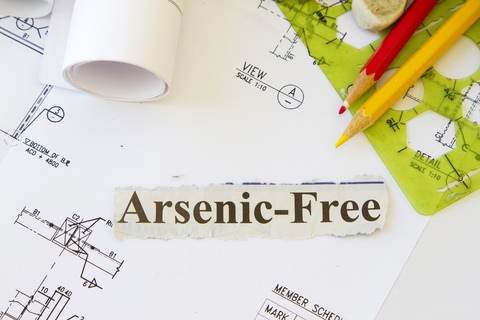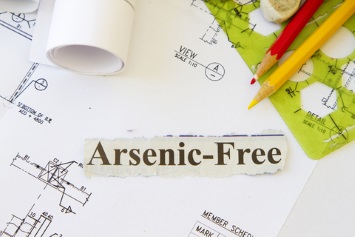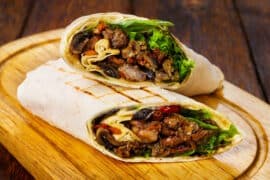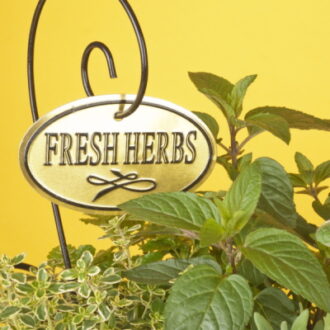Is there really arsenic in rice? It turns out that the answer is “Yes, there is” – and sometimes in amounts that can compromise our health.
We all know that arsenic is a poison. It actually has two chemical forms, organic and inorganic. Organic here is a chemical term and has no relationship to what we usually think of as organic, as in organic food. Organic arsenic is consider less toxic than inorganic arsenic.
Arsenic is found naturally in soil, but it is also added to our soil and water indirectly through the use of both pesticides and poultry fertilizer.
The issue with arsenic in rice occurs because rice absorbs arsenic from soil much more that other plants do. It’s a bit of a “super absorber” of arsenic.
Consumer Reports (www.consumerreports.org) conducted tests in 2012 and again in 2014 to determine exactly how much arsenic is in different varieties of rice. In 2014 their Food Safety and Sustainability Center tested 128 samples of sushi rice, jasmine and basmati rices and combined those results with their own 2012 test results plus FDA (US Federal Department of Agriculture) data on rice products. Altogether they analyzed 697 rice samples, including organic rices. They also tested samples of other grains such as amaranth, millet, buckwheat and quinoa.
Consumer Reports tested a large variety of rice and rice products including hot and cold cereals, infant cereals, dry rice, rice cakes, rice flour, rice crackers, rice flour, rice syrup and rice vinegar.
Here are their findings:
The Findings
Consumer Reports found that every single sample of rice or rice products had detectable levels of arsenic – both organic and inorganic.
The tests also determined that the amount of arsenic in rice varies widely and depends both on the type of rice and where it was grown.
“In virtually every product tested, we found measurable amounts of total arsenic in its two forms,” says Consumer Reports. “We found significant levels of inorganic arsenic, which is a carcinogen, in almost every product category, along with organic arsenic, which is less toxic but still of concern.”
Which Rice is Best?
Brown rice has about 80% more inorganic arsenic (the worst kind) than they same type of whit rice. That makes sense when you consider that when the rice plant absorbs the arsenic from the soil, it accumulates mostly in the outer shell or bran. Brown rice contains the bran, while white rice has had the bran removed.
Brown rice contains more fiber and nutrients that white rice because it retains the outer bran, BUT also because of the bran it contains more arsenic. I would suggest rotating between brown rice for more fiber and nutrients and white rice because it has less arsenic. Plus follow the tips below for reducing the amount of arsenic in your rice.
Of the white rices tested there was a wide span of results based largely on where it was grown. Here are the highest (worst) and lowest tested rices:
Best Tested Rices
The tested rices that were shown to contain the least amount of inorganic arsenic were:
- white basmati rice from California
- white basmati rice from India
- white basmati rice from Pakistan
- sushi rice from the US
Worst Tested Rices
The types of rice that contained the most inorganic arsenic were grown in:
- Arkansas
- Missouri
- Texas
- Louisiana
- rice labelled only that it was grown in the US
Exceptions to this were sushi rice and quick cooking rice from those states, which were not as high in arsenic. All other rices grown in these areas were high in arsenic.
Is Organic Rice Better?
We look to products grown organically to protect us from toxins and poisons. That’s why we buy them. Unfortunately that is not the case with arsenic in rice. As Consumer Reports says, “rice that’s grown organically takes up arsenic the same way conventional rice does, so don’t rely on organic to have less arsenic”.
Some of the organic rice and rice products that were shown to contain similar levels of arsenic as non-organically grown rice include such much loved products and brands as:
- Whole Foods 365 Everyday Value Long Grain Brown Rice
- Earth’s Best Organic Whole Grain Rice Infant Cereal
- Lundberg Family Farms rice
- Trader Joe’s Organic Brown Rice Crisps
- Several Bob’s Red Mill rice products
- Organic Rice Dream Classic Original Rice Drink
and more.
After the arsenic in rice reports were released by Consumer Reports, Grant Lundberg, CEO of Lundberg Family Farms stated that his company will begin testing their products and will disclose those results to the FDA.
Lundberg says “We’re committed to providing safe food, to really listening to our consumers, and dealing with this problem very openly because doing the research needed to assess what the risks really are is the only way to go”.
Jay Highman is the CEO and president of Nature’s One, an Ohio company that produces the nation’s first organic baby formula. He was highly concerned when the Consumer Reports study implicated his formula as containing arsenic. The problem was in the organic brown rice syrup used in the formula.
Highman searched for the purest source for rice. He found it outside of the U.S. and worked with his syrup supplier to develop a filtration process that would eliminate detectable levels of arsenic. When the new product was tested, the levels of arsenic were either undetectable or close to it. So it can be done.
What About Other Grains?
As I indicated above, tests were also conducted on other grains as well. All of the alternate grains tested had aresenic levels far below any of the rices. Some of the grains had negligible amounts of inorganic arsenic. They include amaranth, millet and buckwheat. Other grains with very little arsenic were farro, bulgur, barley and quinoa.
To lower your exposure to arsenic eat a variety of grains.
Lowering the Level of Arsenic in Your Rice
The presence of arsenic in rice in the amounts that were shown in the tests is certainly of concern, especially for those of us who were choosing “healthier” brown rice. Fortunately there are a couple of adjustments we can make when we cook rice to remove some of the arsenic before we consume it. If you cook your rice using the method below, research has shown that you will reduce the arsenic by about 30%. Couple that with choosing a rice that is lower in naturally occurring inorganic arsenic and you can significantly reduce your exposure to this toxin.
1. First of all, rinse your raw rice thoroughly before you cook it. Rinsing rice is a common practice in many cuisines and from now on, it is a process I will recommend and do in my own kitchen.
2. Rice packages often recommend cooking rice in 2X the amount of water as rice to retain nutrients. In many Asian and West Indian cultures the traditional method of cooking rice (not cooked in a rice cooker) is to boil it in much more water, usually 1 cup of rice to 5 or 6 cups of water. When the rice is cooked, simply drain off the water. This allows the arsenic that has been released into the water during cooking to be removed with the discarded water.
Regulations
You might think that the amount of arsenic in rice would be regulated in the US or Canada, but that isn’t so.
Health Canada spokesperson Gary Holub says: “We do have federal limits for the amount of arsenic foods”, but those regulations do not currently include rice.
In the United States, the FDA has not set limits on the allowable amount of arsenic in foods. Arsenic levels in water, are regulated however, with 10 parts per billion (ppb) being the allowable limit. Some rice products were found to have far more than that.
“We already know that high concentrations of arsenic in drinking water result in the highest known toxic substance disease risks from any environmental exposure,” says Allan Smith, M.D., Ph.D., a professor of epidemiology at the University of California, Berkeley. “So we should not be arguing to wait for years until we have results of epidemiologic studies at lower arsenic intake, such as from rice consumption, to take action.” Dr. Smith’s studied the levels of arsenic in public water in Chile and Argentina. He strongly feels that his results helped to show that it causes lung and bladder cancer and other diseases.
The US EPA (Environmental Protection Agency) has declared that, based on the scientific studies already conducted, there are no “safe” levels of exposure to inorganic arsenic.
Although the FDA states that arsenic is naturally occurring in the soil, humans are more to blame for the high levels of arsenic in our foods today than natural minerals in the soil according to the federal Agency for Toxic Substances and Disease Registry. No one can deny that the U.S. is the world’s leading user of arsenic, and in both the US and Canada, we have been using it for a long time. Statistics show that about 1.6 million tons have been used for agricultural and industrial purposes since 1910.
We also have residues of arsenic lingering in our soil from the decades of insecticide use, even though lead-arsenate insecticides have been banned since the 1980’s. Once we do damage with toxins, they stay with us for a very long time. Animal feed and fertilizer made from poultry waste can also contaminate food crops with arsenic.
We have done a lot of damage to ourselves through the use of industrial chemicals and industrialized agriculture. We are now seeing the proof in things like the high levels of arsenic in rice, cereals, baby foods and juices.
What do you think governments should do about arsenic and other toxins in our food chain? Please feel free to comment below.
And don’t forget – rinse your rice thoroughly before cooking it, cook it in lots of water and drain it completely before eating it. Try other grains too, to limit your exposure to the arsenic in rice.
Click here for Consumer Reports’ complete listing of their research findings on arsenic in rice.
Want to be the first to know about new recipes and articles on Cookingnook.com? Sign up here for site updates.
References:
http://www.consumerreports.org/cro/magazine/2015/01/how-much-arsenic-is-in-your-rice/index.htm
http://www.naturalnews.com/041976_brown_rice_arsenic_food_contamination.html#ixzz3NmJddcky
https://ca.shine.yahoo.com/blogs/shine-on/concerned-arsenic-levels-rice-report-says-yes-194751115.html
http://www.consumerreports.org/cro/magazine/2012/11/arsenic-in-your-food/index.htm
If you like this page, please take a moment to Pin it to Pinterest, Tweet about it, Like it on Facebook and leave a comment below. Thanks a lot.













